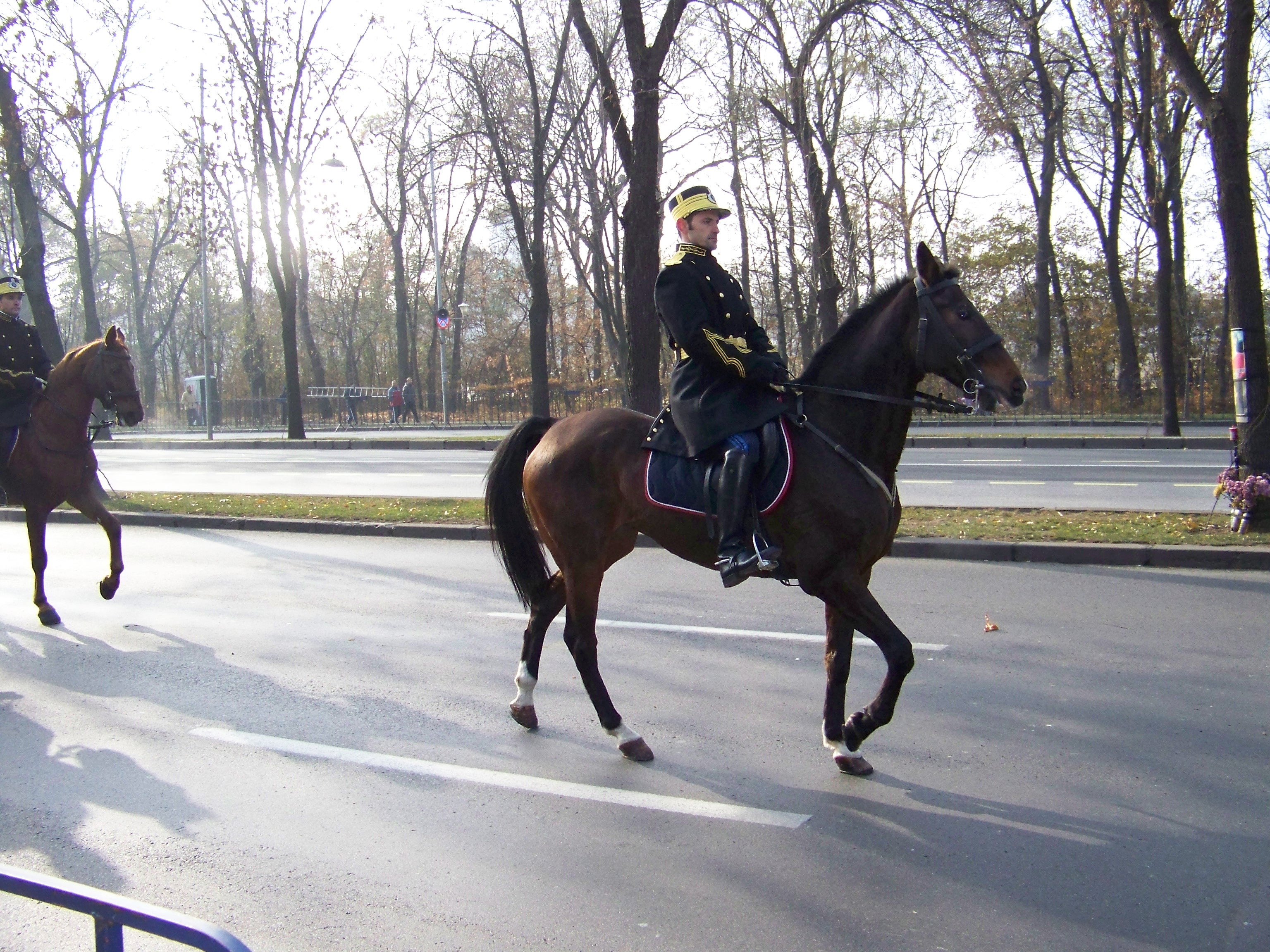|
Coat Of Arms Of The Romanian Gendarmerie
The heraldic ensigns of the Gendarmerie consist of the following elements: large blue shield with a crusader golden eagle, having its head turned to the right, red peak and claws, open wings, holding a silver sword in its right claw; the green olive branch, symbolizing peace and order, replacing the mace from the coat of arms of the country. The small blue shield, placed on the eagle’s chest, having a silver rhombus, coming out of a three leaf garland and having a stylized "J" letter in the midst. At the bottom of the external shield, on a white scarf, the motto of the ministry is written in black: la, LEX ET ORDO. The rhombus symbolizes the life, the prosperity, the reward. The letter "J" signifies, since the nineteenth century, the Romanian Gendarmerie. The oak leaf garland symbolizes the power of sacrifice and duration of the lawful state. References Website of the Romanian Ministry of Interior and Administrative Reform {{Romanian heraldry Gendarmerie Coat of arms of the Ro ... [...More Info...] [...Related Items...] OR: [Wikipedia] [Google] [Baidu] |
Romanian Gendarmerie
The ''Jandarmeria Română'' () is the national Gendarmerie force of Romania, tasked with high-risk and specialized law enforcement duties. It is one of the two main police forces in Romania (the other being the Romanian Police - a civilian force), both having jurisdiction over the civilian population. The gendarmerie is subordinated Ministry of Internal Affairs and does not have responsibility for policing the Romanian Armed Forces. This duty lies with the Military Police subordinated to the Romanian Land Forces. History The beginnings The first Gendarmerie corps was created on 3 April 1850 in Moldavia by Prince Grigore Alexandru Ghica. After the Union of Moldavia and Wallachia in 1859 under Prince Alexandru Ioan Cuza, the Gendarmerie was subordinated to the Ministry of War as a separate armed force.''Repere istorice'' , ... [...More Info...] [...Related Items...] OR: [Wikipedia] [Google] [Baidu] |
Shield
A shield is a piece of personal armour held in the hand, which may or may not be strapped to the wrist or forearm. Shields are used to intercept specific attacks, whether from close-ranged weaponry or projectiles such as arrows, by means of active blocks, as well as to provide passive protection by closing one or more lines of engagement during combat. Shields vary greatly in size and shape, ranging from large panels that protect the user's whole body to small models (such as the buckler) that were intended for hand-to-hand-combat use. Shields also vary a great deal in thickness; whereas some shields were made of relatively deep, absorbent, wooden planking to protect soldiers from the impact of spears and crossbow bolts, others were thinner and lighter and designed mainly for deflecting blade strikes (like the roromaraugi or qauata). Finally, shields vary greatly in shape, ranging in roundness to angularity, proportional length and width, symmetry and edge pattern; different s ... [...More Info...] [...Related Items...] OR: [Wikipedia] [Google] [Baidu] |
Coat Of Arms
A coat of arms is a heraldry, heraldic communication design, visual design on an escutcheon (heraldry), escutcheon (i.e., shield), surcoat, or tabard (the latter two being outer garments). The coat of arms on an escutcheon forms the central element of the full achievement (heraldry), heraldic achievement, which in its whole consists of a shield, supporters, a crest (heraldry), crest, and a motto. A coat of arms is traditionally unique to an individual person, family, state, organization, school or corporation. The term itself of 'coat of arms' describing in modern times just the heraldic design, originates from the description of the entire medieval chainmail 'surcoat' garment used in combat or preparation for the latter. Roll of arms, Rolls of arms are collections of many coats of arms, and since the early Modern Age centuries, they have been a source of information for public showing and tracing the membership of a nobility, noble family, and therefore its genealogy across tim ... [...More Info...] [...Related Items...] OR: [Wikipedia] [Google] [Baidu] |
Romanian Heraldry
The Romanian government is the armiger in Romania. It exercises this right under the mandatory advice of the National Committee of Heraldry, Genealogy and Sigillography ( ro, Comisia Națională de Heraldică, Genealogie și Sigilografie). The committee is subordinate to the Romanian Academy. All the coats of arms of Romanian institutions must be approved by this committee with two exceptions. The Romanian military is subject to the Ministry of National Defense Heraldric Committee, and Romanian law enforcement institutions are subject to the Ministry of Administration and Interior Heraldric Committee. Both of these committees may share members with the National Committee of Heraldry, Genealogy and Sigillography. Romanian coats of arms File:LDAM (f. 025) Rei de Blaqui.jpg, Arms of the King of Vlachs from the Portuguese ''Livro do Armeiro-Mor''. (Perhaps from the Second Bulgarian Empire). File:Arms, House of Basarab.png, Arms of Basarab House File:Arms of Mircea I of Wallachi ... [...More Info...] [...Related Items...] OR: [Wikipedia] [Google] [Baidu] |
Gendarmerie
Wrong info! --> A gendarmerie () is a military force with law enforcement duties among the civilian population. The term ''gendarme'' () is derived from the medieval French expression ', which translates to " men-at-arms" (literally, "armed people"). In France and some Francophone nations, the gendarmerie is a branch of the armed forces that is responsible for internal security in parts of the territory (primarily in rural areas and small towns in the case of France), with additional duties as military police for the armed forces. It was introduced to several other Western European countries during the Napoleonic conquests. In the mid-twentieth century, a number of former French mandates and colonial possessions (such as Lebanon, Syria, the Ivory Coast and the Republic of the Congo) adopted a gendarmerie after independence. A similar concept exists in Eastern Europe in the form of Internal Troops, which are present in many countries of the former Soviet Union and its ... [...More Info...] [...Related Items...] OR: [Wikipedia] [Google] [Baidu] |



